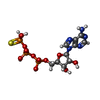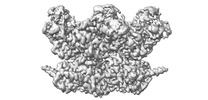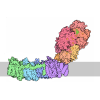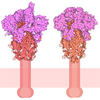+ Open data
Open data
- Basic information
Basic information
| Entry | Database: EMDB / ID: EMD-24519 | |||||||||
|---|---|---|---|---|---|---|---|---|---|---|
| Title | Cryo-EM structure of human p97-R155H mutant bound to ATPgS. | |||||||||
 Map data Map data | Cryo-EM structure of human p97-R155H bound to ATPgS. | |||||||||
 Sample Sample |
| |||||||||
 Keywords Keywords | p97 / VCP / TERA / Inhibitor / CB-5083 / HYDROLASE | |||||||||
| Function / homology |  Function and homology information Function and homology information: / flavin adenine dinucleotide catabolic process / VCP-NSFL1C complex / endosome to lysosome transport via multivesicular body sorting pathway / endoplasmic reticulum stress-induced pre-emptive quality control / BAT3 complex binding / cellular response to arsenite ion / protein-DNA covalent cross-linking repair / Derlin-1 retrotranslocation complex / positive regulation of protein K63-linked deubiquitination ...: / flavin adenine dinucleotide catabolic process / VCP-NSFL1C complex / endosome to lysosome transport via multivesicular body sorting pathway / endoplasmic reticulum stress-induced pre-emptive quality control / BAT3 complex binding / cellular response to arsenite ion / protein-DNA covalent cross-linking repair / Derlin-1 retrotranslocation complex / positive regulation of protein K63-linked deubiquitination / cytoplasm protein quality control / positive regulation of oxidative phosphorylation / : / aggresome assembly / deubiquitinase activator activity / mitotic spindle disassembly / ubiquitin-modified protein reader activity / regulation of protein localization to chromatin / VCP-NPL4-UFD1 AAA ATPase complex / cellular response to misfolded protein / negative regulation of protein localization to chromatin / positive regulation of mitochondrial membrane potential / vesicle-fusing ATPase / K48-linked polyubiquitin modification-dependent protein binding / regulation of aerobic respiration / retrograde protein transport, ER to cytosol / stress granule disassembly / ATPase complex / regulation of synapse organization / ubiquitin-specific protease binding / positive regulation of ATP biosynthetic process / MHC class I protein binding / ubiquitin-like protein ligase binding / RHOH GTPase cycle / polyubiquitin modification-dependent protein binding / autophagosome maturation / negative regulation of hippo signaling / HSF1 activation / endoplasmic reticulum to Golgi vesicle-mediated transport / translesion synthesis / interstrand cross-link repair / ATP metabolic process / endoplasmic reticulum unfolded protein response / proteasomal protein catabolic process / Protein methylation / Attachment and Entry / ERAD pathway / lipid droplet / proteasome complex / viral genome replication / Josephin domain DUBs / negative regulation of smoothened signaling pathway / N-glycan trimming in the ER and Calnexin/Calreticulin cycle / macroautophagy / establishment of protein localization / Hh mutants are degraded by ERAD / positive regulation of protein-containing complex assembly / Hedgehog ligand biogenesis / Defective CFTR causes cystic fibrosis / positive regulation of non-canonical NF-kappaB signal transduction / Translesion Synthesis by POLH / ADP binding / ABC-family proteins mediated transport / autophagy / cytoplasmic stress granule / Aggrephagy / positive regulation of protein catabolic process / azurophil granule lumen / Ovarian tumor domain proteases / KEAP1-NFE2L2 pathway / positive regulation of canonical Wnt signaling pathway / positive regulation of proteasomal ubiquitin-dependent protein catabolic process / double-strand break repair / E3 ubiquitin ligases ubiquitinate target proteins / cellular response to heat / site of double-strand break / Neddylation / ubiquitin-dependent protein catabolic process / secretory granule lumen / protein phosphatase binding / regulation of apoptotic process / ficolin-1-rich granule lumen / proteasome-mediated ubiquitin-dependent protein catabolic process / Attachment and Entry / protein ubiquitination / ciliary basal body / protein domain specific binding / DNA repair / intracellular membrane-bounded organelle / DNA damage response / ubiquitin protein ligase binding / Neutrophil degranulation / lipid binding / endoplasmic reticulum membrane / perinuclear region of cytoplasm / glutamatergic synapse / endoplasmic reticulum / ATP hydrolysis activity / protein-containing complex / RNA binding Similarity search - Function | |||||||||
| Biological species |  Homo sapiens (human) Homo sapiens (human) | |||||||||
| Method | single particle reconstruction / cryo EM / Resolution: 3.0 Å | |||||||||
 Authors Authors | Caffrey B / Zhu X / Berezuk A / Tuttle K / Chittori S / Subramaniam S | |||||||||
 Citation Citation |  Journal: J Biol Chem / Year: 2021 Journal: J Biol Chem / Year: 2021Title: AAA+ ATPase p97/VCP mutants and inhibitor binding disrupt inter-domain coupling and subsequent allosteric activation. Authors: Brian Caffrey / Xing Zhu / Alison Berezuk / Katharine Tuttle / Sagar Chittori / Sriram Subramaniam /  Abstract: The human AAA+ ATPase p97, also known as valosin-containing protein, a potential target for cancer therapeutics, plays a vital role in the clearing of misfolded proteins. p97 dysfunction is also ...The human AAA+ ATPase p97, also known as valosin-containing protein, a potential target for cancer therapeutics, plays a vital role in the clearing of misfolded proteins. p97 dysfunction is also known to play a crucial role in several neurodegenerative disorders, such as MultiSystem Proteinopathy 1 (MSP-1) and Familial Amyotrophic Lateral Sclerosis (ALS). However, the structural basis of its role in such diseases remains elusive. Here, we present cryo-EM structural analyses of four disease mutants p97, p97, p97, p97, as well as p97, implicated in resistance to the drug CB-5083, a potent p97 inhibitor. Our cryo-EM structures demonstrate that these mutations affect nucleotide-driven allosteric activation across the three principal p97 domains (N, D1, and D2) by predominantly interfering with either (1) the coupling between the D1 and N-terminal domains (p97 and p97), (2) the interprotomer interactions (p97), or (3) the coupling between D1 and D2 nucleotide domains (p97, p97). We also show that binding of the competitive inhibitor, CB-5083, to the D2 domain prevents conformational changes similar to those seen for mutations that affect coupling between the D1 and D2 domains. Our studies enable tracing of the path of allosteric activation across p97 and establish a common mechanistic link between active site inhibition and defects in allosteric activation by disease-causing mutations and have potential implications for the design of novel allosteric compounds that can modulate p97 function. | |||||||||
| History |
|
- Structure visualization
Structure visualization
| Movie |
 Movie viewer Movie viewer |
|---|---|
| Structure viewer | EM map:  SurfView SurfView Molmil Molmil Jmol/JSmol Jmol/JSmol |
| Supplemental images |
- Downloads & links
Downloads & links
-EMDB archive
| Map data |  emd_24519.map.gz emd_24519.map.gz | 31.9 MB |  EMDB map data format EMDB map data format | |
|---|---|---|---|---|
| Header (meta data) |  emd-24519-v30.xml emd-24519-v30.xml emd-24519.xml emd-24519.xml | 12.2 KB 12.2 KB | Display Display |  EMDB header EMDB header |
| FSC (resolution estimation) |  emd_24519_fsc.xml emd_24519_fsc.xml | 11.7 KB | Display |  FSC data file FSC data file |
| Images |  emd_24519.png emd_24519.png | 61.7 KB | ||
| Filedesc metadata |  emd-24519.cif.gz emd-24519.cif.gz | 5.8 KB | ||
| Archive directory |  http://ftp.pdbj.org/pub/emdb/structures/EMD-24519 http://ftp.pdbj.org/pub/emdb/structures/EMD-24519 ftp://ftp.pdbj.org/pub/emdb/structures/EMD-24519 ftp://ftp.pdbj.org/pub/emdb/structures/EMD-24519 | HTTPS FTP |
-Validation report
| Summary document |  emd_24519_validation.pdf.gz emd_24519_validation.pdf.gz | 517 KB | Display |  EMDB validaton report EMDB validaton report |
|---|---|---|---|---|
| Full document |  emd_24519_full_validation.pdf.gz emd_24519_full_validation.pdf.gz | 516.5 KB | Display | |
| Data in XML |  emd_24519_validation.xml.gz emd_24519_validation.xml.gz | 11 KB | Display | |
| Data in CIF |  emd_24519_validation.cif.gz emd_24519_validation.cif.gz | 14.4 KB | Display | |
| Arichive directory |  https://ftp.pdbj.org/pub/emdb/validation_reports/EMD-24519 https://ftp.pdbj.org/pub/emdb/validation_reports/EMD-24519 ftp://ftp.pdbj.org/pub/emdb/validation_reports/EMD-24519 ftp://ftp.pdbj.org/pub/emdb/validation_reports/EMD-24519 | HTTPS FTP |
-Related structure data
| Related structure data |  7rl7MC  7rl6C  7rl9C  7rlaC  7rlbC  7rlcC  7rldC  7rlfC  7rlgC  7rlhC  7rliC  7rljC M: atomic model generated by this map C: citing same article ( |
|---|---|
| Similar structure data |
- Links
Links
| EMDB pages |  EMDB (EBI/PDBe) / EMDB (EBI/PDBe) /  EMDataResource EMDataResource |
|---|---|
| Related items in Molecule of the Month |
- Map
Map
| File |  Download / File: emd_24519.map.gz / Format: CCP4 / Size: 64 MB / Type: IMAGE STORED AS FLOATING POINT NUMBER (4 BYTES) Download / File: emd_24519.map.gz / Format: CCP4 / Size: 64 MB / Type: IMAGE STORED AS FLOATING POINT NUMBER (4 BYTES) | ||||||||||||||||||||||||||||||||||||||||||||||||||||||||||||||||||||
|---|---|---|---|---|---|---|---|---|---|---|---|---|---|---|---|---|---|---|---|---|---|---|---|---|---|---|---|---|---|---|---|---|---|---|---|---|---|---|---|---|---|---|---|---|---|---|---|---|---|---|---|---|---|---|---|---|---|---|---|---|---|---|---|---|---|---|---|---|---|
| Annotation | Cryo-EM structure of human p97-R155H bound to ATPgS. | ||||||||||||||||||||||||||||||||||||||||||||||||||||||||||||||||||||
| Projections & slices | Image control
Images are generated by Spider. | ||||||||||||||||||||||||||||||||||||||||||||||||||||||||||||||||||||
| Voxel size | X=Y=Z: 1.0125 Å | ||||||||||||||||||||||||||||||||||||||||||||||||||||||||||||||||||||
| Density |
| ||||||||||||||||||||||||||||||||||||||||||||||||||||||||||||||||||||
| Symmetry | Space group: 1 | ||||||||||||||||||||||||||||||||||||||||||||||||||||||||||||||||||||
| Details | EMDB XML:
CCP4 map header:
| ||||||||||||||||||||||||||||||||||||||||||||||||||||||||||||||||||||
-Supplemental data
- Sample components
Sample components
-Entire : Full-length Hexameric p97-R155H mutant.
| Entire | Name: Full-length Hexameric p97-R155H mutant. |
|---|---|
| Components |
|
-Supramolecule #1: Full-length Hexameric p97-R155H mutant.
| Supramolecule | Name: Full-length Hexameric p97-R155H mutant. / type: complex / ID: 1 / Parent: 0 / Macromolecule list: #1 |
|---|---|
| Source (natural) | Organism:  Homo sapiens (human) Homo sapiens (human) |
| Molecular weight | Theoretical: 540 KDa |
-Macromolecule #1: Transitional endoplasmic reticulum ATPase
| Macromolecule | Name: Transitional endoplasmic reticulum ATPase / type: protein_or_peptide / ID: 1 / Number of copies: 6 / Enantiomer: LEVO / EC number: vesicle-fusing ATPase |
|---|---|
| Source (natural) | Organism:  Homo sapiens (human) Homo sapiens (human) |
| Molecular weight | Theoretical: 91.212602 KDa |
| Recombinant expression | Organism:  |
| Sequence | String: HHHHHHGTSE NLYFQGASGA DSKGDDLSTA ILKQKNRPNR LIVDEAINED NSVVSLSQPK MDELQLFRGD TVLLKGKKRR EAVCIVLSD DTCSDEKIRM NRVVRNNLRV RLGDVISIQP CPDVKYGKRI HVLPIDDTVE GITGNLFEVY LKPYFLEAYR P IRKGDIFL ...String: HHHHHHGTSE NLYFQGASGA DSKGDDLSTA ILKQKNRPNR LIVDEAINED NSVVSLSQPK MDELQLFRGD TVLLKGKKRR EAVCIVLSD DTCSDEKIRM NRVVRNNLRV RLGDVISIQP CPDVKYGKRI HVLPIDDTVE GITGNLFEVY LKPYFLEAYR P IRKGDIFL VHGGMRAVEF KVVETDPSPY CIVAPDTVIH CEGEPIKRED EEESLNEVGY DDIGGCRKQL AQIKEMVELP LR HPALFKA IGVKPPRGIL LYGPPGTGKT LIARAVANET GAFFFLINGP EIMSKLAGES ESNLRKAFEE AEKNAPAIIF IDE LDAIAP KREKTHGEVE RRIVSQLLTL MDGLKQRAHV IVMAATNRPN SIDPALRRFG RFDREVDIGI PDATGRLEIL QIHT KNMKL ADDVDLEQVA NETHGHVGAD LAALCSEAAL QAIRKKMDLI DLEDETIDAE VMNSLAVTMD DFRWALSQSN PSALR ETVV EVPQVTWEDI GGLEDVKREL QELVQYPVEH PDKFLKFGMT PSKGVLFYGP PGCGKTLLAK AIANECQANF ISIKGP ELL TMWFGESEAN VREIFDKARQ AAPCVLFFDE LDSIAKARGG NIGDGGGAAD RVINQILTEM DGMSTKKNVF IIGATNR PD IIDPAILRPG RLDQLIYIPL PDEKSRVAIL KANLRKSPVA KDVDLEFLAK MTNGFSGADL TEICQRACKL AIRESIES E IRRERERQTN PSAMEVEEDD PVPEIRRDHF EEAMRFARRS VSDNDIRKYE MFAQTLQQSR GFGSFRFPSG NQGGAGPSQ GSGGGTGGSV YTEDNDDDLY G UniProtKB: Transitional endoplasmic reticulum ATPase |
-Macromolecule #2: PHOSPHOTHIOPHOSPHORIC ACID-ADENYLATE ESTER
| Macromolecule | Name: PHOSPHOTHIOPHOSPHORIC ACID-ADENYLATE ESTER / type: ligand / ID: 2 / Number of copies: 12 / Formula: AGS |
|---|---|
| Molecular weight | Theoretical: 523.247 Da |
| Chemical component information |  ChemComp-AGS: |
-Macromolecule #3: MAGNESIUM ION
| Macromolecule | Name: MAGNESIUM ION / type: ligand / ID: 3 / Number of copies: 12 / Formula: MG |
|---|---|
| Molecular weight | Theoretical: 24.305 Da |
-Experimental details
-Structure determination
| Method | cryo EM |
|---|---|
 Processing Processing | single particle reconstruction |
| Aggregation state | 2D array |
- Sample preparation
Sample preparation
| Concentration | 2 mg/mL | |||||||||||||||||||||
|---|---|---|---|---|---|---|---|---|---|---|---|---|---|---|---|---|---|---|---|---|---|---|
| Buffer | pH: 8 Component:
Details: Protein Storage Buffer with ATPgS. | |||||||||||||||||||||
| Vitrification | Cryogen name: ETHANE |
- Electron microscopy
Electron microscopy
| Microscope | FEI TITAN KRIOS |
|---|---|
| Image recording | Film or detector model: GATAN K3 (6k x 4k) / Number real images: 5265 / Average electron dose: 50.0 e/Å2 |
| Electron beam | Acceleration voltage: 300 kV / Electron source:  FIELD EMISSION GUN FIELD EMISSION GUN |
| Electron optics | Illumination mode: FLOOD BEAM / Imaging mode: BRIGHT FIELD |
| Experimental equipment |  Model: Titan Krios / Image courtesy: FEI Company |
 Movie
Movie Controller
Controller


































 Z (Sec.)
Z (Sec.) Y (Row.)
Y (Row.) X (Col.)
X (Col.)






















